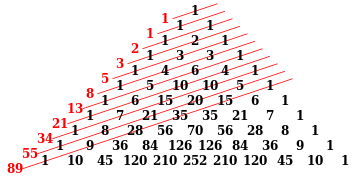数学 におけるフィボナッチ多項式 (フィボナッチたこうしき、英 : Fibonacci polynomials )とは、フィボナッチ数 の一般化として見られるある多項式列 のことを言う。同様にリュカ数 の一般化として得られる多項式列のことはリュカ数 (Lucas polynomials)と言う。
フィボナッチ多項式 は、次の漸化式 より得られる[ 1]
F
n
(
x
)
=
{
0
,
if
n
=
0
1
,
if
n
=
1
x
F
n
−
1
(
x
)
+
F
n
−
2
(
x
)
,
if
n
≥
2
{\displaystyle F_{n}(x)={\begin{cases}0,&{\mbox{if }}n=0\\1,&{\mbox{if }}n=1\\xF_{n-1}(x)+F_{n-2}(x),&{\mbox{if }}n\geq 2\end{cases}}}
初めのいくつかのフィボナッチ多項式を書くと、次のようになる:
F
0
(
x
)
=
0
{\displaystyle F_{0}(x)=0\,}
F
1
(
x
)
=
1
{\displaystyle F_{1}(x)=1\,}
F
2
(
x
)
=
x
{\displaystyle F_{2}(x)=x\,}
F
3
(
x
)
=
x
2
+
1
{\displaystyle F_{3}(x)=x^{2}+1\,}
F
4
(
x
)
=
x
3
+
2
x
{\displaystyle F_{4}(x)=x^{3}+2x\,}
F
5
(
x
)
=
x
4
+
3
x
2
+
1
{\displaystyle F_{5}(x)=x^{4}+3x^{2}+1\,}
F
6
(
x
)
=
x
5
+
4
x
3
+
3
x
{\displaystyle F_{6}(x)=x^{5}+4x^{3}+3x\,}
リュカ多項式は、初めの値が異なるだけで、同様の漸化式より得られる[ 2]
L
n
(
x
)
=
{
2
,
if
n
=
0
x
,
if
n
=
1
x
L
n
−
1
(
x
)
+
L
n
−
2
(
x
)
,
if
n
≥
2.
{\displaystyle L_{n}(x)={\begin{cases}2,&{\mbox{if }}n=0\\x,&{\mbox{if }}n=1\\xL_{n-1}(x)+L_{n-2}(x),&{\mbox{if }}n\geq 2.\end{cases}}}
初めのいくつかのリュカ多項式は次のようになる:
L
0
(
x
)
=
2
{\displaystyle L_{0}(x)=2\,}
L
1
(
x
)
=
x
{\displaystyle L_{1}(x)=x\,}
L
2
(
x
)
=
x
2
+
2
{\displaystyle L_{2}(x)=x^{2}+2\,}
L
3
(
x
)
=
x
3
+
3
x
{\displaystyle L_{3}(x)=x^{3}+3x\,}
L
4
(
x
)
=
x
4
+
4
x
2
+
2
{\displaystyle L_{4}(x)=x^{4}+4x^{2}+2\,}
L
5
(
x
)
=
x
5
+
5
x
3
+
5
x
{\displaystyle L_{5}(x)=x^{5}+5x^{3}+5x\,}
L
6
(
x
)
=
x
6
+
6
x
4
+
9
x
2
+
2.
{\displaystyle L_{6}(x)=x^{6}+6x^{4}+9x^{2}+2.\,}
フィボナッチ数およびリュカ数は、それぞれの多項式において x = 1 とすることで得られる。ペル数 は F n x = 2 とすることで得られる。F n n − 1 で、L n n である。これらの多項式列の通常母関数 は次のようになる[ 3]
∑
n
=
0
∞
F
n
(
x
)
t
n
=
t
1
−
x
t
−
t
2
{\displaystyle \sum _{n=0}^{\infty }F_{n}(x)t^{n}={\frac {t}{1-xt-t^{2}}}}
∑
n
=
0
∞
L
n
(
x
)
t
n
=
2
−
x
t
1
−
x
t
−
t
2
.
{\displaystyle \sum _{n=0}^{\infty }L_{n}(x)t^{n}={\frac {2-xt}{1-xt-t^{2}}}.}
これらの多項式列は、リュカ数列 を使うことで次のように表現することが出来る:
F
n
(
x
)
=
U
n
(
x
,
−
1
)
,
{\displaystyle F_{n}(x)=U_{n}(x,-1),\,}
L
n
(
x
)
=
V
n
(
x
,
−
1
)
.
{\displaystyle L_{n}(x)=V_{n}(x,-1).\,}
リュカ数列の特別な場合として、フィボナッチ多項式は以下に述べる多くの関係式を満たす。
初めに、負の添え字に対しては次の関係式が成り立つ[ 4]
F
−
n
(
x
)
=
(
−
1
)
n
−
1
F
n
(
x
)
,
L
−
n
(
x
)
=
(
−
1
)
n
L
n
(
x
)
.
{\displaystyle F_{-n}(x)=(-1)^{n-1}F_{n}(x),\,L_{-n}(x)=(-1)^{n}L_{n}(x).}
また、次の関係式が成り立つ[ 4]
F
m
+
n
(
x
)
=
F
m
+
1
(
x
)
F
n
(
x
)
+
F
m
(
x
)
F
n
−
1
(
x
)
{\displaystyle F_{m+n}(x)=F_{m+1}(x)F_{n}(x)+F_{m}(x)F_{n-1}(x)\,}
L
m
+
n
(
x
)
=
L
m
(
x
)
L
n
(
x
)
−
(
−
1
)
n
L
m
−
n
(
x
)
{\displaystyle L_{m+n}(x)=L_{m}(x)L_{n}(x)-(-1)^{n}L_{m-n}(x)\,}
F
n
+
1
(
x
)
F
n
−
1
(
x
)
−
F
n
(
x
)
2
=
(
−
1
)
n
{\displaystyle F_{n+1}(x)F_{n-1}(x)-F_{n}(x)^{2}=(-1)^{n}\,}
F
2
n
(
x
)
=
F
n
(
x
)
L
n
(
x
)
.
{\displaystyle F_{2n}(x)=F_{n}(x)L_{n}(x).\,}
ビネットの公式と同様に、閉形式表現は次のようになる[ 4]
F
n
(
x
)
=
α
(
x
)
n
−
β
(
x
)
n
α
(
x
)
−
β
(
x
)
,
L
n
(
x
)
=
α
(
x
)
n
+
β
(
x
)
n
.
{\displaystyle F_{n}(x)={\frac {\alpha (x)^{n}-\beta (x)^{n}}{\alpha (x)-\beta (x)}},\,L_{n}(x)=\alpha (x)^{n}+\beta (x)^{n}.}
ただし
α
(
x
)
=
x
+
x
2
+
4
2
,
β
(
x
)
=
x
−
x
2
+
4
2
{\displaystyle \alpha (x)={\frac {x+{\sqrt {x^{2}+4}}}{2}},\,\beta (x)={\frac {x-{\sqrt {x^{2}+4}}}{2}}}
は次の(t に関する)方程式の解である:
t
2
−
x
t
−
1
=
0.
{\displaystyle t^{2}-xt-1=0.\,}
フィボナッチ多項式の係数は、パスカルの三角形の「浅い」対角(赤線)を読むことで求められる。それら係数の和は、フィボナッチ数である。 Fn (x ) における xk の係数を F (n ,k ) と表す。すなわち
F
n
(
x
)
=
∑
k
=
0
n
F
(
n
,
k
)
x
k
,
{\displaystyle F_{n}(x)=\sum _{k=0}^{n}F(n,k)x^{k},\,}
とする。このとき F (n ,k ) は、 2 × 1 のドミノ とちょうど k 個の 1 × 1 の正方形を使って、n −1 × 1 の長方形を埋める方法の数に等しい[ 1] F (n ,k ) は、1 をちょうど k 回使って、1 と 2 のみからなる順序付の和で n −1 を書く方法の数に等しい。例えば F(6,3)=4 であるが、これ 1 をちょうど 3 回使って、1 と 2 のみからなる順序付の和で 6-1 = 5 を書く方法 1+1+1+2, 1+1+2+1, 1+2+1+1, 2+1+1+1 の数 4 に等しい。そのような和で用いられる 1 と 2 の数を数えることで、F (n ,k ) は二項係数
F
(
n
,
k
)
=
(
n
+
k
−
1
2
k
)
{\displaystyle F(n,k)={\binom {\tfrac {n+k-1}{2}}{k}}}
に等しい。ここで n と k は異なるパリティ(奇偶性)を持つ。このことから、右図のようにパスカルの三角形 からフィボナッチ多項式の係数を求めることが出来る。
^ a b Benjamin & Quinn p. 141
^ Benjamin & Quinn p. 142
^ Weisstein, Eric W. "Fibonacci Polynomial" . mathworld.wolfram.com (英語). ^ a b c Springer
Benjamin, Arthur T.; Quinn, Jennifer J. (2003). “§9.4 Fibonacci and Lucas Polynomial”. Proofs that Really Count . MAA. p. 141. ISBN 0-88385-333-7 Philippou, Andreas N. (2001), “Fibonacci polynomials” , in Hazewinkel, Michiel, Encyclopedia of Mathematics ISBN 978-1-55608-010-4 , https://www.encyclopediaofmath.org/index.php?title=Fibonacci_polynomials&oldid=14185 Philippou, Andreas N. (2001), “Lucas polynomials” , in Hazewinkel, Michiel, Encyclopedia of Mathematics ISBN 978-1-55608-010-4 , https://www.encyclopediaofmath.org/index.php?title=Lucas_polynomials&oldid=17297 Weisstein, Eric W. "Lucas Polynomial" . mathworld.wolfram.com (英語).
Hoggatt, V. E. ; Bicknell, Marjorie (1973). “Roots of Fibonacci polynomials.”. Fibonacci Quarterly 11 : 271–274. ISSN 0015-0517 . MR 0332645 . Hoggatt, V. E.; Long, Calvin T. (1974). “Divisibility properties of generalized Fibonacci Polynomials”. Fibonacci Quarterly 12 : 113. MR 0352034 . Ricci, Paolo Emilio (1995). “Generalized Lucas polynomials and Fibonacci polynomials”. Rivista di Matematica della Università di Parma . V. Ser. 4 : 137–146. MR 1395332 . Yuan, Yi; Zhang, Wenpeng (2002). “Some identities involving the Fibonacci Polynomials”. Fibonacci Quarterly 40 (4): 314. MR 1920571 . Cigler, Johann (2003). “q-Fibonacci polynomials”. Fibonacci Quarterly (41): 31–40. MR 1962279 .






























